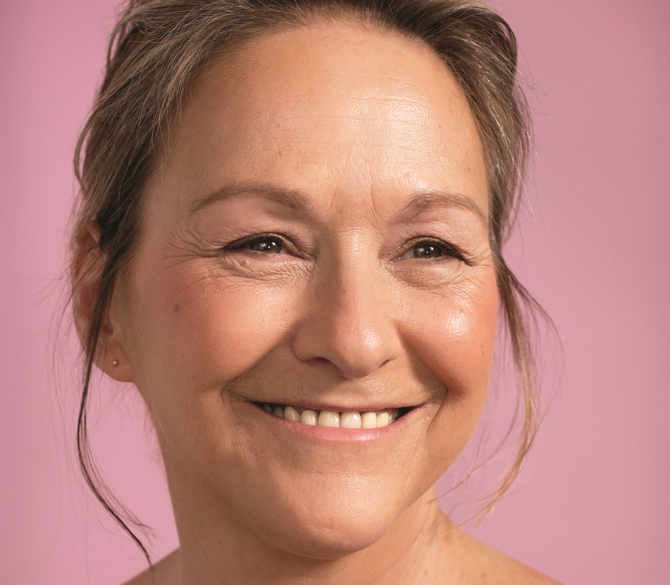Whether you’re curious about peels, scrubs or in-salon skin treatments, our mini-guide can help you demystify this fundamental skin-care step
By Mariève Inoue
For many, exfoliation is an essential part of an effective skin-care routine. But how does it work? “Our body’s cells turn over every 28 days,” says Liz Kwitman, the vice-president of education (Americas) at Caudalie. “But as we get older, that process slows down and we have to help our system out.” An accumulation of dead cells can lead to rough and dull skin. So exfoliating regularly can help refine the skin’s texture, even out the complexion, brighten the look of the skin, boost product absorption and promote healthy cell regeneration, according to Myriam Nadeau and Maude Guillemette, a territory manager and lead educator, respectively, at the medicalesthetic- clinic network Epiderma. Here are some of the essentials of exfoliation.
Acids
There are two main types of exfoliation: chemical and physical. Chemical exfoliation is usually done by applying alpha hydroxy acids (AHAs) and/or beta hydroxy acids (BHAs) to the skin. “Both types dissolve dead skin cells and help increase cell turnover,” says Kwitman.
AHAs include glycolic, lactic and mandelic acids, and some of their superpowers are evening out skin tone, lightening dark spots and hydrating the skin.
Because BHAs are fat-soluble, they penetrate deeper into the pores. So if you have blackheads or other blocked pores, salicylic acid (the most common BHA) is an excellent ally; its anti-inflammatory properties also help reduce redness.
Recently, polyhydroxy acids (PHAs) have started appearing in formulas: these larger molecules are part of the AHA family but they work closer to the surface, making them a great choice for sensitive skin.
Chemical vs. Mechanical
Chemical exfoliation is done via acids (AHAs, BHAs, PHAs) and enzymes. The latter work similarly to acids, but only help dissolve dead skin cells, making them particularly well-suited to sensitive skin.
Peels, as well as treatments with skin-care products that contain fruit acids and/or enzymes, fall under the umbrella of chemical exfoliation.
Mechanical (or physical) exfoliation occurs when you use a product that contains granules or small beads, or when you use a washcloth, a cleansing brush or a scrubbing mitt.
Some products combine both types, mixing chemical exfoliants with scrubbing properties. And many spas and beauty salons offer micropeels, which combine microdermabrasion (a type of mechanical exfoliation) with the chemical exfoliation of a peel.
Frequency
How often you should exfoliate depends on several factors: “It varies according to your skin type and its level of sensitivity, as well as your lifestyle and preferences,” says Kwitman.
For example, if your daily skin-care regimen consists of only moisturizer and sunscreen, you could use an AHA mask or a scrub once or twice a week.
On the other hand, if you use an essence, serum or cream that includes enzymes or a low concentration of glycolic acid to maintain your daily glow, a regular scrub likely won’t be necessary.
Nadeau and Guillemette recommend getting your skin analyzed before starting an at-home exfoliation routine.
Depending on your skin type, they advise a once- or twiceweekly schedule.
Microdermabrasion
This involves a microcrystal powder being crushed on the skin, followed by a vacuuming action. Microdermabrasion is available at spas and beauty salons and is suitable for all skin types. “The pulverized crystals remove impurities and dead skin cells, while the vacuum stimulates microcirculation,” explains Nadeau. This type of mechanical exfoliation also activates the skin’s production of collagen and elastin, which work to firm the skin.
Night vs. Day
Nighttime is best suited to this step in your skin-care routine, so it’s no surprise that exfoliating acids are often found in night creams. However, if you prefer to use a daytime moisturizer with chemical exfoliants, make sure your product has an SPF of at least 30 to protect your skin against the sun’s UV rays.
Peels
Wash-off masks that contain chemical exfoliants are often called peels, but you can also get a peel treatment, commonly with glycolic acid, at spas and beauty salons.
“The active ingredients in professional settings are a lot more concentrated than in products you use at home,” says Nadeau. You can choose from among many types of peels depending on individual needs, but most peels will deliver a brighter complexion and reduce the number of dark spots.
Routines
Once you’ve exfoliated your skin, you’ll need to take good care of those fresh new skin cells. Here are some ingredients to look for in your skin-care products, according to Liz Kwitman:
-Antioxidants, including vitamin C, vitamin E and polyphenols. “Antioxidants are your friends because they fight free radicals caused by pollution, cigarette smoke, screens, fluorescent lighting and everything else.”
-Hyaluronic acid, which is produced by the body and helps maintain skin’s plumpness. “By age 40, you’ve lost half of your natural reserves of hyaluronic acid, which is why it’s so important an ingredient for nourishing new skin.”
-Niacinamide. “This is a kind of superhero ingredient; it has anti-inflammatory properties and is great for targeting dark spots as well as brightening and fortifying the skin.”
Scrubs
There are face, body and even scalp scrubs. Sugar crystals, plant-derived microbeads and other types of granules help eliminate dead skin cells through physical exfoliation; they also help activate blood circulation. Body scrubs, with their often energizing or sweet fragrances, also make for a delightful showering experience.
Overexfoliation
Exfoliation provides the skin with many benefits, but it’s important not to overdo it. “A common mistake is to want to do everything at once: people use a nubby washcloth to cleanse their faces with a combined AHA-BHA cleanser, then apply a retinoid and wonder why their skin is red and sensitive,” says Dr. Kavita Mariwalla, a U.S.-based dermatologist. She compares the skin, our largest organ, to a brick wall.
One of its main roles is to keep viruses and bacteria from entering the body. Exfoliating removes what builds up on this wall to help keep it as stable and strong as possible. But if you exfoliate too often, she says, “you start to chip away at the bricks and mortar, so your skin can as a result become red and more prone to irritation by heat and UV rays.” Itchiness, increased sensitivity, dehydration and even broken blood vessels are other signs you might have overdone it.
What should you do if this is the case?
First, stop all forms of exfoliation. Next, says Mariwalla, “you have to repair your skin by moisturizing like crazy with ingredients such as hyaluronic acid, which will help rebalance the water loss that’s linked to overexfoliation.” Reach for a pH-balanced cleanser and be gentle— and patient, as it can take several days or even weeks for the skin to fully heal.
Once your skin has calmed down, you can slowly, gradually and carefully reintroduce exfoliation into your routine.
Body and Face
Exfoliating your face is one thing, but the rest of your body can also benefit from a regular scrub treatment—especially rougher areas such as the elbows and heels. You can also get a professional peel for your neck, décolleté and hands to help reduce dark spots and even out skin tone, advise Nadeau and Guillemette.
Photo credit: Marc-Antoine Charlebois






